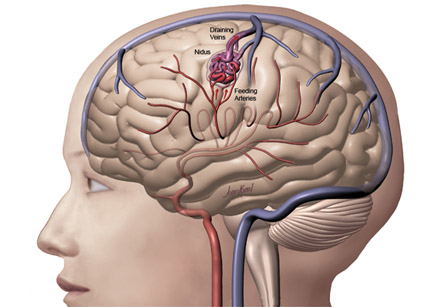AV Malformations
Introduction
Arterio-venous (AV) malformations (AVM) occur during foetal development or soon after birth. These are the defects in the circulatory systems. In these malformations arteries and veins are tangled with each other. They can occur in any part of the body but those in brain and spinal cord affect the human body most. They have widespread effects on human body.
These AVMs are identified incidentally. Normally people with AVM rarely have significant signs and symptoms. Seizure and headaches are the most common signs and symptoms. Headaches may vary in severity. AVMs become more symptomatic when brain or spinal cord is damaged. In those cases neurological deficits or internal bleeding may occur.
Conventional surgery is considered when AVM is located superficially.
Internal bleeding is the potential life threatening dangers associated with AVMs. Angiography helps to identify the nature and extent of AVMs. Angiography involves injection of a radioactive or contrast dye into the vein of the arm. On imaging with CT scan and MRI of the affected area the blood vessels and their malformations show up vividly making diagnosis easier
The cause of AVMs is not clear. Most people are born with them, but they can occasionally form later in life. They are rarely passed down among families genetically

Medications are used to treat and alleviate symptoms and signs like headache, seizures, back pain etc. But the definitive treatment is either surgery or irradiation. Decision of surgery should be carefully considered on the back drop of possible risk benefit ratio. Natural history of AVMs is difficult to predict. If they are left untreated it may lead to internal bleeding leading to neurological deficits or death. On the other hand surgery of AVMs poses substantial risks.
Three types of surgery may be undertaken
• Conventional surgery
• Endovascular embolization
• Radiosurgery
Conventional surgery is considered when AVM is located superficially. Deep seated AVMs cannot be reached through this procedure. Endovascular embolization is less invasive in nature. The surgeon plugs the fistula and corrects the abnormality of the blood flow. An artificial blood clot is created at the centre of an AVM. Radiosurgery is another less invasive procedure. A beam of radiation is directly focussed on AVM.
Over the period of time there is resolution of the AVM. Different factors are involved in treating AVMs and all these procedures carry their own risks. The physicians need to assess all the facts before deciding to choose a particular treatment. Patient will also be counselled regarding the risks and benefits of each of the procedures.